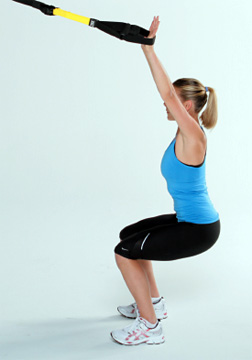 |
|
| ||||||||
|
|
|
continued...
 This exercise enables you to work the posterior chain by limiting flexion and controlling the upper torso. The two straps and handles attached to the central anchor point increase stability and prevent poor technique. (See image at right).
This exercise enables you to work the posterior chain by limiting flexion and controlling the upper torso. The two straps and handles attached to the central anchor point increase stability and prevent poor technique. (See image at right).
Single-leg movements on a suspension trainer, such as reverse lunges, are easier to perform and less intimidating for clients who are new to corrective exercise, since body-weight load on the leg can be altered easily by handle and strap positioning. (To see an example of this exercise, access the online version of this article at DCPracticeInsights.com. Search under "Nickelston" or visit the July 2011 issue.) Functional Training Rehabilitation programs should always include functional training principles. Functional training typically involves an integration of multi-planar total-body exercises with variable challenges to load, balance and stability. It is an exercise continuum involving balance and proprioception performed without machine assistance. This enables your clients to become more adept at accomplishing activities associated with daily living such as bending, twisting, turning and rotating. It is common in rehabilitation to prescribe exercises that are focused solely on the injured or symptomatic area. This negates the principle of a full-body continuum of multi-joint, movement-based rehab. During activities of daily living, the body does not move in isolated patterns. It moves as an integrated unit, be it functional or dysfunctional. Either way, it moves! Suspension training engages the entire body, and hence the core, with every exercise. This full-body engagement is partly under volitional control, while challenges to balance and stability rely on feedback-mediated adjustments and anticipatory control. Depending upon the phase of rehabilitation and individual needs, exercises may be modified to place more emphasis on motor- control adaptations than tissue adaptations. To increase motor control, it is necessary to establish static and dynamic stabilization. During the performance of whole-body, multi-planar exercises, muscular and joint forces are distributed across the bod,y thus lessening the load of direct impact on volatile tissue. Finding activities that enable a patient to confidently perform and progress on their exercise program is important to long-term success in a rehabilitation program. Given the opportunity, clients will usually perform an exercise with poor technique. Be steadfast in your observation and coaching of movement. Keep in mind that it takes time for the neuromuscular system to learn a new behavior. Observe whole-body movement patterns via suspension training to see if you have corrected the underlying dysfunctional problem. It's an unforgiving system of checks and balances. When it comes to patient care, you should accept nothing less. Unique Appeal Suspension training has a unique crossover appeal from rehabilitation into fitness and performance. Clients can easily integrate this form of exercise into their current program or lifestyle. Suspension training equipment is cost-effective and portable, allowing for ease of use in the clinical setting and the home environment. Patients may purchase the inexpensive equipment directly from you, thus adding to practice revenue from product sales. In addition, you will have a broader appeal to the athletic population and can even organize group exercise classes to expand your practice services. You can feel confident knowing that clients will continue their home-prescribed program because they enjoy the movements, and more importantly, they see and feel the results! The Practice Benefits of Suspension Training
References
Click here for more information about Perry Nickelston, DC, FMS, SFMA.
|
Chiropractic Events
|
||||
|
|
|||||